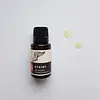What's inside
What's inside
 Key Ingredients
Key Ingredients

No key ingredients
 Benefits
Benefits

 Concerns
Concerns

 Ingredients Side-by-side
Ingredients Side-by-side

Melia Azadirachta Seed Oil
EmollientCannabis Sativa Seed Oil
EmollientRosa Canina Fruit Oil
EmollientCalendula Officinalis Flower
Skin ConditioningChamomilla Recutita Oil
MaskingDipotassium Glycyrrhizate
HumectantHelianthus Annuus Seed Oil
EmollientSimmondsia Chinensis Seed Oil
EmollientHelichrysum Italicum Flower Oil
MaskingMyrtenal
PerfumingThymol
AntimicrobialLavandula Angustifolia Oil
MaskingSambucus Nigra Fruit Extract
AstringentIsododecane
EmollientMelia Azadirachta Seed Oil, Cannabis Sativa Seed Oil, Rosa Canina Fruit Oil, Calendula Officinalis Flower, Chamomilla Recutita Oil, Dipotassium Glycyrrhizate, Helianthus Annuus Seed Oil, Simmondsia Chinensis Seed Oil, Helichrysum Italicum Flower Oil, Myrtenal, Thymol, Lavandula Angustifolia Oil, Sambucus Nigra Fruit Extract, Isododecane
Nigella Sativa Seed Oil
EmollientRosa Canina Fruit Oil
EmollientCalophyllum Inophyllum Seed Oil
AntimicrobialHelianthus Annuus Seed Oil
EmollientSymphytum Officinale Root Extract
Skin ConditioningNigella Sativa Seed Oil, Rosa Canina Fruit Oil, Calophyllum Inophyllum Seed Oil, Helianthus Annuus Seed Oil, Symphytum Officinale Root Extract, Olea Europaea Leaf Extract, Lavandula Angustifolia Oil, Simmondsia Chinensis Seed Oil, Melaleuca Alternifolia Leaf Oil, Helichrysum Italicum Flower Oil, Matricaria Recutita Flower Oil, Rosmarinus Officinalis Leaf Extract
 Reviews
Reviews

Ingredients Explained
These ingredients are found in both products.
Ingredients higher up in an ingredient list are typically present in a larger amount.
Helianthus Annuus Seed Oil is the oil derived from the seeds of a Sunflower. Sunflower seed oil is non-fragrant. It is an emollient, meaning it helps to soften the skin.
Sunflower seed oil contains many fatty acids. The fatty acids found in sunflower seeds include (from highest amount to least): linoleic acid, myristic acid, palmitic acid, stearic acid, arachidic acid, oleic acid, and linolenic acid.
These fatty acids help the skin create ceramides. Ceramides play a role in repairing the skin barrier.
Helianthus Annuus Seed Oil helps moisturize the skin. This in turn helps the skin look more rejuvenated and smoother.
Sunflowers are rich in vitamin E.
Historians believe Indigenous cultures of North America domesticated sunflowers before corn. Thus they relied on sunflower oil for a variety of uses. One such use is moisturizing skin and hair.
Sunflower seed oil may not be fungal acne safe. We recommend speaking with a professional if you have any concerns.
Learn more about Helianthus Annuus Seed OilHelichrysum Italicum Flower Oil is a fragrance, is an oil, and isn't fungal acne safe.
Lavandula Angustifolia Oil is more commonly known as lavender essential oil. It is considered a fragrancing ingredient.
Lavender imparts a famous scent. While the smell is lovely, this ingredient and may sensitize skin in topical products. This is because about 85% of the oil is made up of linalool and linalyl acetate.
When exposed to air, these two compounds become strong allergens. This ingredient exhibits cytotoxicity at low concentrations; amounts of 0.25% have been shown to damage skin cells.
A study from Japan found this ingredient caused lavender sensitivity after widespread exposure.
Lavender essential oil has some antimicrobial, antibacterial, and anti-inflammatory properties. However, the cons of this ingredient may outweight the pros.
More research is needed to confirm lavender essential oil's effects when used in aromatherapy.
Lavandula Angustifolia is known as the English Lavender and famous for creating purple fields in Provence, France.
Learn more about Lavandula Angustifolia OilRosehip Oil is a non-fragrant plant oil. Rosehips are a fruit from a rose bush and are edible. This oil has skin conditioning and hydrating properties.
Rosehip contains Vitamin C, Vitamin E, fatty acids and linolenic acids. These nourish your skin barrier. Having hydrated skin may help reduce the appearance of fine-lines and wrinkles.
Another great component of Rosehip Oil is Vitamin A, or retinol. Vitamin A encourages your skin to create more collagen.
Rosehip oil may help with reducing pigmentation. The lycopene and beta-carotene have skin-lightening properties. However, more studies are needed to confirm this.
Learn more about Rosa Canina Fruit OilThis oil comes from the seeds of the desert shrub called Jojoba. It is more commonly known as jojoba oil, a non-comedogenic oil.
Jojoba oil does not contain fragrance and has many fatty-acids, making it a great soothing ingredient.
It also contains Vitamin E, a great moisturizing ingredient. Vitamin E is also an antioxidant and protects your skin against oxidative damage.
This ingredient humectant properties, meaning it helps draw moisture from the air. This helps keep your skin hydrated.
While jojoba has antibacterial properties, it is only able to kill some strains of bacteria.
Studies also show it helps in wound healing. In fact, Indigenous cultures have used jojoba as a moisturizer and to help treat burns for centuries.
Fun fact: Jojoba oil similar to natural human skin sebum, so it has a great effect on dry skin. It is also promising with helping to regulate sebum production.
Due to its fatty acid content, Jojoba oil may not be fungal acne safe. We recommend speaking with a professional if you have any concerns.
Learn more about Simmondsia Chinensis Seed Oil